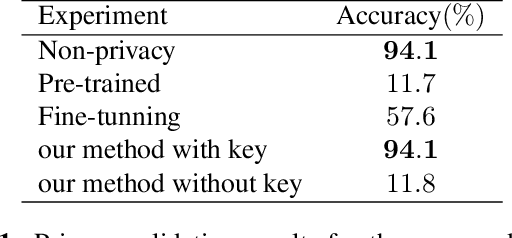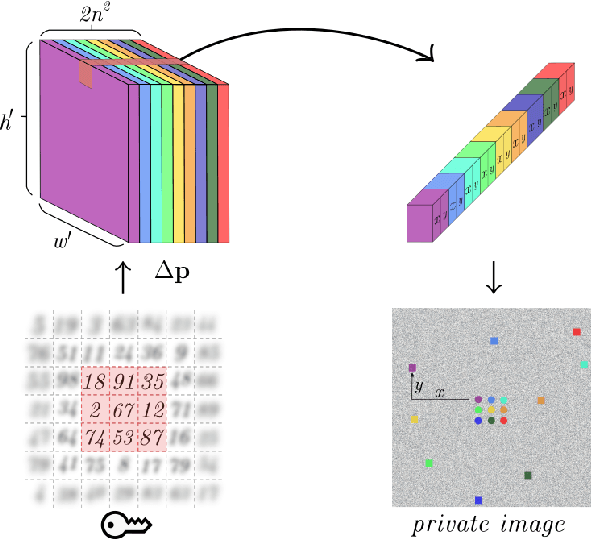Jhon Lopez
Privacy-Preserving Deep Learning Using Deformable Operators for Secure Task Learning
Apr 08, 2024



Abstract:In the era of cloud computing and data-driven applications, it is crucial to protect sensitive information to maintain data privacy, ensuring truly reliable systems. As a result, preserving privacy in deep learning systems has become a critical concern. Existing methods for privacy preservation rely on image encryption or perceptual transformation approaches. However, they often suffer from reduced task performance and high computational costs. To address these challenges, we propose a novel Privacy-Preserving framework that uses a set of deformable operators for secure task learning. Our method involves shuffling pixels during the analog-to-digital conversion process to generate visually protected data. Those are then fed into a well-known network enhanced with deformable operators. Using our approach, users can achieve equivalent performance to original images without additional training using a secret key. Moreover, our method enables access control against unauthorized users. Experimental results demonstrate the efficacy of our approach, showcasing its potential in cloud-based scenarios and privacy-sensitive applications.
Privacy-preserving Optics for Enhancing Protection in Face De-identification
Mar 31, 2024Abstract:The modern surge in camera usage alongside widespread computer vision technology applications poses significant privacy and security concerns. Current artificial intelligence (AI) technologies aid in recognizing relevant events and assisting in daily tasks in homes, offices, hospitals, etc. The need to access or process personal information for these purposes raises privacy concerns. While software-level solutions like face de-identification provide a good privacy/utility trade-off, they present vulnerabilities to sniffing attacks. In this paper, we propose a hardware-level face de-identification method to solve this vulnerability. Specifically, our approach first learns an optical encoder along with a regression model to obtain a face heatmap while hiding the face identity from the source image. We also propose an anonymization framework that generates a new face using the privacy-preserving image, face heatmap, and a reference face image from a public dataset as input. We validate our approach with extensive simulations and hardware experiments.
Depth Estimation from a Single Optical Encoded Image using a Learned Colored-Coded Aperture
Sep 14, 2023Abstract:Depth estimation from a single image of a conventional camera is a challenging task since depth cues are lost during the acquisition process. State-of-the-art approaches improve the discrimination between different depths by introducing a binary-coded aperture (CA) in the lens aperture that generates different coded blur patterns at different depths. Color-coded apertures (CCA) can also produce color misalignment in the captured image which can be utilized to estimate disparity. Leveraging advances in deep learning, more recent works have explored the data-driven design of a diffractive optical element (DOE) for encoding depth information through chromatic aberrations. However, compared with binary CA or CCA, DOEs are more expensive to fabricate and require high-precision devices. Different from previous CCA-based approaches that employ few basic colors, in this work we propose a CCA with a greater number of color filters and richer spectral information to optically encode relevant depth information in a single snapshot. Furthermore, we propose to jointly learn the color-coded aperture (CCA) pattern and a convolutional neural network (CNN) to retrieve depth information by using an end-to-end optimization approach. We demonstrate through different experiments on three different data sets that the designed color-encoding has the potential to remove depth ambiguities and provides better depth estimates compared to state-of-the-art approaches. Additionally, we build a low-cost prototype of our CCA using a photographic film and validate the proposed approach in real scenarios.
 Add to Chrome
Add to Chrome Add to Firefox
Add to Firefox Add to Edge
Add to Edge